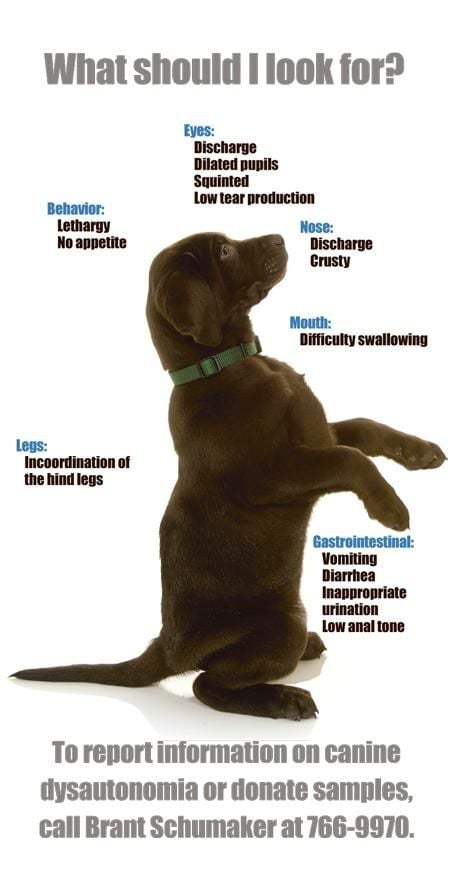
Canine dysautonomia was first described in England in 1983 but the disease has not been diagnosed there for many years. The disease is frequently misdiagnosed and treated as a respiratory or gastrointestinal condition due to the appearance of the initial symptoms which include.

Canine dysautonomia was first described in England in 1983 but the disease has not been diagnosed there for many years.
Canine dysautonomia. Canine dysautonomia is a degenerative polyneuropathy characterized by neuronal degeneration within the autonomic somatic central peripheral andor enteric nervous system causing multisystemic effects similar if not identical to the dysautonomia in horses cats rabbits and hares. Canine dysautonomia was first described in England in 1983 but the disease has not been diagnosed there for many years. The disease is frequently misdiagnosed and treated as a respiratory or gastrointestinal condition due to the appearance of the initial symptoms which include.
Vomiting or regurgitation especially if severe or long-lasting Dilated pupils Low or absent. Canine Dysautonomia CD is a sporadic and largely fatal autonomic neurological disorder that has been seen in the United States United Kingdom and areas of Western Europe. After numerous investigations into CD an etiologic agent has not yet been identified.
Canine dysautonomia CD is a sporadic generally fatal disease of dogs. It is due to degeneration of nerve cells controlling subconscious bodily functions. These include control of normal swallowing and motility of the digestive tract heart function control of urination and pupils of the eye.
The cause of CD is unknown at this time. Other likely clues that your dog has dysautonomia are. Painful urination Dilation of the eyes Lack of pupil reaction to light Inflammation of the bladder Dry mouth nose and eyes Loss of appetite Obvious loss of weight extreme Vomiting Diarrhea Losing control of bowels and urination.
Early Signs of Canine Dysautonomia. Vomiting or regurgitating food Dry crusty nose Dilated pupils diarrhea Thick nasal discharge Lower tear production Third eyelid protrusion Difficulty urinating or defecating others in the below graphic. Dysuria mydriasis absence of pupillary light reflexes decreased tear production dry mucous membranes weight loss and decreased anal tone were present in over 75 of affected dogs.
Ocular pharmacological testing with a dilute 01 solution of pilocarpine was used to demonstrate iris sphincter receptor function in all dogs. Two clinical cases of canine dysautonomia are described. Two young female neutered dogs were presented with clinical signs including vomiting diarrhoea faecal tenesmus dysphagia and urinary retention.
Decreased tear production dry mucous membranes. Researchers say Dysautonomia affects mainly puppies but it can also affect older dogs. Again-its not known what causes the illness where it is or.
Canine dysautonomia is a disorder of the autonomic nervous system which controls many reflexes and other neurologic functions that the animal does not consciously control. Other components of the nervous system including central peripheral skeletal and digestive nerves are also affected. 22 2015 Sunny Selvey pictured began to show symptoms of canine dysautonomia a rare disease found in dogs ages 14-18 months.
Symptoms can include severe intractable vomiting lasting. Dogs from rural environments were overrepresented and cases of dysautonomia were reported for every month although the highest number of cases was reported in February and March. Vomiting was the most common clinical sign followed by diarrhea signs of anorexia and depression weight loss and dysuria.
A Retrospective Study Randall C. Grooters and Robert A. Kroll Dysautonomia was diagnosed in 11 young median age 14- months predominantly medium- to large-breed dogs from 1988 to 1995.
Clinical signs caused by autonomic dysfunction. Canine Dysautonomia was something I had never heard of until the day Jill died. I promised myself that I would set out to do everything I could to tell Jills Story in the hopes of saving just one other family from our tragic and traumatic loss.
Dysautonomia is an umbrella term for conditions in which the autonomic nervous system malfunctions. Press J to jump to the feed. Press question mark to learn the rest of the keyboard shortcuts.
Log In Sign Up. Saw this cutie- service dog for dysautonomia and more. Canine Dysautonomia was something I had never heard of until the day Jill died.
I promised myself that I would set out to do everything I could to tell Jills Story in the hopes of saving just one other family from our tragic and traumatic loss. Please take a moment and share this video with as.